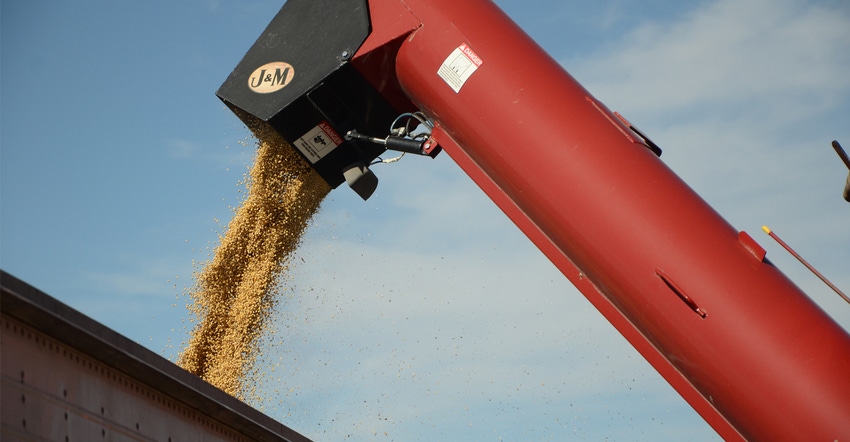October 12, 2018

By Anil Giri, Wes Peterson and Sankalp Sharma
In July, the Trump administration announced that $12 billion had been set aside to assist farmers affected by retaliatory Chinese tariffs placed on U.S. exports.
Three programs have been set up to carry out an initial distribution of about $6.3 billion. The most important is the Market Facilitation Program (MFP), for which about $4.7 billion has been set aside. After Sept. 4 of this year, producers who have completed their harvests became eligible for initial payments based on the published payment rates applied to half their reported production. The initial payment rate for soybeans, for example, is $1.65 per bushel, compared with only 1 cent per bushel for corn. These payment rates reflect the importance of the Chinese market for the two commodities, and the likelihood that the impact of the tariffs would be greater for soybeans than for corn. In 2017, U.S. corn exports to China accounted for only 1.6% of total U.S. corn exports while China bought 57.1% of total U.S. soybean exports. According to USDA estimates, more than 77% of the anticipated MFP payments will be paid to soybean producers.
In addition to the MFP program, about $1.4 billion will be used to purchase a wide range of consumer products for use in various nutrition assistance programs, and $200,000 is to be made available for promotional programs operated by the Foreign Agriculture Service (FAS) on a cost-share basis with eligible advertising and promotional organizations. To receive MFP payments, farmers must be in compliance with conservation requirements, and the average annual adjusted gross income of the farm enterprise from 2014 to 2016 must be less than $900,000. In addition, the MFP payments cannot exceed $125,000 per producer or legal entity. A second round of MFP payments may be undertaken at a later date. Further information about the MFP is available at www.farmers.gov/manage/mfp.
Potential impact in Nebraska
Since the payments are only made on 50% of total production, the effective rates are equal to half of the announced payment rates (0.005 cents per bushel for corn and 0.825 cents per bushel for soybeans). This means that, if the 2018 average yield for corn were equal to the USDA August forecast of 196 bushels per acre, farmers would receive 98 cents per acre (196 x 0.5 x 0.01) on average. Similarly, if the 2018 yield for soybeans were 61 bushels per acre, an average payment would be $50.33 per acre (61 x 0.5 x 1.65).
Total potential MFP payments for different yield scenarios are shown in Table 1, along with total expected revenue using the opening Sept. 3 futures prices ($3.65 and $8.46 per bushel for corn and soybeans, respectively) from the Chicago Mercantile Exchange, and total revenue including the MFP payments on a per-acre basis. Based on the USDA August yield forecast, farmers growing corn would receive payments of 98 cents per acre which, when added to the expected revenue, would yield total revenue of $716.38 per acre. Similarly, for soybeans, the payment of $50.33 added to expected revenue would result in total per-acre revenue of $566.39 based on the August forecast.

Table 1: Per-acre MFP payment and gross revenue estimates for Nebraska. Source: Cornhusker Economics

MFP payments for different amounts of acreage harvested of corn and soybeans based on the August yield forecast are shown in Table 2. With these yields, a producer who harvests more than 2,484 acres of soybeans would receive only $125,000 — the maximum payment allowed. If 5,000 acres of soybeans are harvested with a yield of 61 bushels per acre, the per-acre revenue would be only $541.06, compared to $566.39 for lower harvested acres as a result of the cap.

Table 2: Total revenue estimates for Nebraska. Source: Cornhusker Economics

These results show how the MFP program would affect farm revenue for corn and soybean producers in Nebraska, assuming average yields and prices equal to the Sept. 3 futures price. The situation for individual farmers will vary depending on actual yields and the pricing strategies pursued. If a farmer has locked in a forward-contract price of $9 per bushel of soybeans and managed a yield of 63 bushels per acre, the MFP payment of $51.98 would be added to revenue of $567 per acre, for a total with the payment of $618.98 per acre — substantially more than the amounts shown in Table 1. Variation in farmers’ circumstances with respect to actual yields and prices makes it difficult to determine whether the MFP payments will fully compensate, overcompensate, or undercompensate particular producers for any losses brought about by Chinese tariffs. Of course, compensation could be avoided altogether if — instead of the self-inflicted damage of the U.S.-China trade war — workable trade agreements and resolution of disputes through the World Trade Organization were pursued, so that farmers could market their products at prices determined by market conditions rather than at the tariff-distorted prices.
Giri is an assistant professor in the School of Natural Sciences at the University of Central Missouri; Peterson is a professor in the Department of Agricultural Economics at the University of Nebraska-Lincoln; and Sharma is an assistant professor of agribusiness at Kent State University-Tuscarawas in Ohio. This report comes from Cornhusker Economics.
You May Also Like




